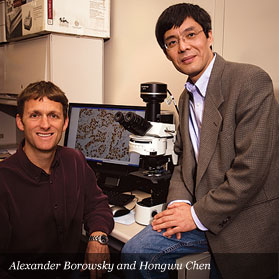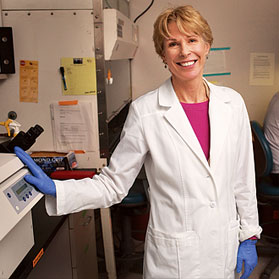Making their mark against breast cancer
 "A biomarker can be clinically useful by itself. But if at the same time it has the potential to serve as a target, then its value is twofold."
"A biomarker can be clinically useful by itself. But if at the same time it has the potential to serve as a target, then its value is twofold."
Yet for many decades, the treatment for most patients was essentially the same. Doctors removed tumors via mastectomy or lumpectomy, sometimes added radiation to treat the site, administered chemotherapy to reduce the risk of metastasis, then both patient and doctors hoped for a cure.
That treatment scenario is now much more individualized. Researchers have found ways to classify tumors by their molecular characteristics. Now every breast tumor biopsy is subjected to three tests to determine whether the tumor produces estrogen receptor (ER), progesterone receptor (PR) or human epidermal growth factor receptor 2 (HER2). The results help steer clinicians toward therapies directed at these molecules.
But no oncologist will claim that three breast cancer biomarkers are enough. That’s particularly true for patients afflicted with triple-negative tumors. These cancers cannot be treated with drugs that knock down ER, PR or HER2. To make matters worse, triple-negative tumors are notorious for recurrence and poor patient survival rates.
That bleak outlook is set to change. UC Davis Cancer Center researchers are hot on the heels of two new and promising breast cancer biomarkers. They are demonstrating how these molecules affect breast tumor growth, and tracking how patients with these biomarkers fare. In doing so, they hope not only to increase the methods available to characterize breast tumors, but zero in on new ways to research and treat this devastating cancer.
The twofold potential of ANCCA
An associate professor of biochemistry at UC Davis School of Medicine, Hongwu Chen is exposing, one by one, the nasty secrets of a protein called ANCCA. With Alexander Borowsky, an associate professor in the school’s Department of Pathology and Laboratory Medicine, Chen is demonstrating a close association between ANCCA and its role in tumor grade and cancer growth. Their work may be instrumental in finding new therapies for treatment-resistant triple-negative breast tumors.
UC Davis Cancer Center researchers are hot on the heels of two new and promising breast cancer biomarkers.
In 2009, the two reported finding high levels of ANCCA in a broad range of tumors, including prostate, liver, lung, ovarian, endometrial and brain cancers, as well as lymphoma. More recently, they have used the antibodies Borowsky developed to detect ANCCA on 225 breast tumor samples collected at UC Davis Cancer Center.
"ANCCA is common, rampant in human cancers," Chen says. "It was overexpressed in about 70 percent of the tumors we analyzed. That’s unprecedented. Most other proteins considered to be "oncoproteins" are elevated in about 30 to 50 percent of tumors."
Even more striking, however, is ANCCA’s association with triple-negative breast tumors. More than 88 percent of the triple-negative tumors in the study showed high levels of the protein. The finding is particularly surprising, because triple-negative tumors are not considered a homogeneous group. The fact that ANCCA is found in so many "strongly implicates ANCCA as a potential link to the vast majority of the different mechanisms already identified for triple-negative tumors," Chen says.
When matched stage to stage, the tumors with higher levels of ANCCA also tended to be at a more advanced grade (their cells were the most abnormal) and proliferated rapidly. Patients with such tumors also turned out to have the poorest outcomes.
"It was present at lower levels in lower-grade lesions and at higher levels in higher-grade lesions," Borowsky says. This correlation means ANCCA could serve as an excellent biomarker for breast cancer prognosis.
Several lines of evidence make Chen and Borowsky suspect ANCCA also is central to causing disease, including the fact that when the gene was suppressed, cell culture lines were less likely to grow and proliferate.
Both scientists are eager to use ANCCA as a way to gauge how well certain treatments work. Chen already has plans to piggyback additional ANCCA studies on future UC Davis Cancer Center clinical trials. He wants to see whether ANCCA levels turn out to be a good predictor of therapy effectiveness.
"We suspect that along with the grade there are other biological factors that make them hard to treat. We want to know whether ANCCA is one of those alternate pathways that can be targeted with drugs," Borowsky says.
ANCCA also has two structural characteristics, one called a bromodomain and the other an ATPase domain, which are necessary for it to function. Scientists have inactivated similar domains on other proteins with small molecules engineered for the task. This makes Chen and Borowsky hopeful that this approach will result in a drug against ANCCA.
"A biomarker can be clinically useful by itself. But if at the same time it has the potential to serve as a target, then its value is twofold," Chen says.
The implications of extra copies
Cancer is associated with the accumulation of changes in the structure of a cell’s DNA. Among those changes can be the duplication or "amplification" of long stretches of genetic material.
 Krig is thrilled by the twists and turns her research can take. "It’s a daily surprise," she says. But what propels her into the laboratory every workday is more altruistic. "I feel one day our work might help someone."
Krig is thrilled by the twists and turns her research can take. "It’s a daily surprise," she says. But what propels her into the laboratory every workday is more altruistic. "I feel one day our work might help someone."
"That’s probably a bad thing," says Sheryl Krig, a project scientist with the UC Davis School of Medicine Department of Biochemistry and Molecular Medicine. "That means the DNA has been aberrantly duplicated during the genomic and genetic instability that happens during the early stages of cancers."
Roughly 20 such amplification hotspots in the genome have been found to be associated with breast cancer. Krig, who received her Ph.D. in biochemistry and molecular biology at UC Davis in 2001, is investigating whether the amplification of one area in particular, the 20q13 locus, is linked to the risk of tumor metastasis.
"Some tumors will just sit there and not go anywhere," Krig says. "Those patients can just do chemotherapy treatment and forget about the drastic mastectomy.
"Some tumors have the capacity to spread beyond their initial site, a step that is typically fatal." Identifying aggressive tumors is a major headache for oncologists. Krig hopes to solve this problem by developing a biomarker test for early metastatic disease.
Previous studies have found that about 20 percent of breast tumors have multiple copies of 20q13. This location is thought to be the chromosomal area that codes for a protein called ZNF217.
 Identifying aggressive tumors is a major headache for oncologists. Krig hopes to solve this problem by developing a biomarker test for early metastatic disease.
Identifying aggressive tumors is a major headache for oncologists. Krig hopes to solve this problem by developing a biomarker test for early metastatic disease.
Krig and Jeffrey Gregg, a UC Davis associate professor of pathology, plan to test 100 breast tumors that show 20q13 amplification. The researchers will then determine whether the 20q13 locus in these tumors does indeed include multiple copies of the gene for ZNF217. They will try to confirm that tumors with more copies of the gene also have higher levels of ZNF217 expression, then examine how the patients with high versus low ZNF217 levels fared.
"In the samples where we see lots of copies of ZNF217, for example, did the patient die of breast disease or survive? Were they estrogen receptor positive or negative? Were there lymph node metastases? The idea is to determine whether ZNF217 will be a biomarker for the actual degree of aggressiveness of the tumor," Krig says.
Krig also plans to grow breast tumor cells that overexpress ZNF217 in a three-dimensional solid culture matrix. She will study whether the tissues formed by the modified cells are more invasive in a manner similar to what is seen in biopsy samples.
If at the end of the two-year study ZNF217 correlates with more aggressive cell growth in culture and patients, the test will go into clinical trials.
Krig is thrilled by the twists and turns her research can take. "It’s a daily surprise," she says. But what propels her into the laboratory every workday is more altruistic. "I feel one day our work might help someone."







